The Effects of E-Learning on Students: BMSW 4001 Skills & Health
VerifiedAdded on 2023/06/18
|20
|3198
|116
Essay
AI Summary
This essay explores the effects of e-learning on students, examining both positive and negative impacts on their academic and employability skills. It discusses how online learning has altered traditional teaching methods, affecting student-teacher interactions and the development of crucial skills. The essay highlights the benefits of online learning, such as accessibility, flexibility, and the use of visual tools, while also addressing drawbacks like reduced physical activity, potential eye strain, and limited social interaction. Furthermore, the study provides recommendations for enhancing the effectiveness of online learning, including training for parents and children, support for schools lacking resources, and addressing connectivity issues in rural areas. The essay concludes by emphasizing the importance of time management in academic success and provides insights into effective strategies.
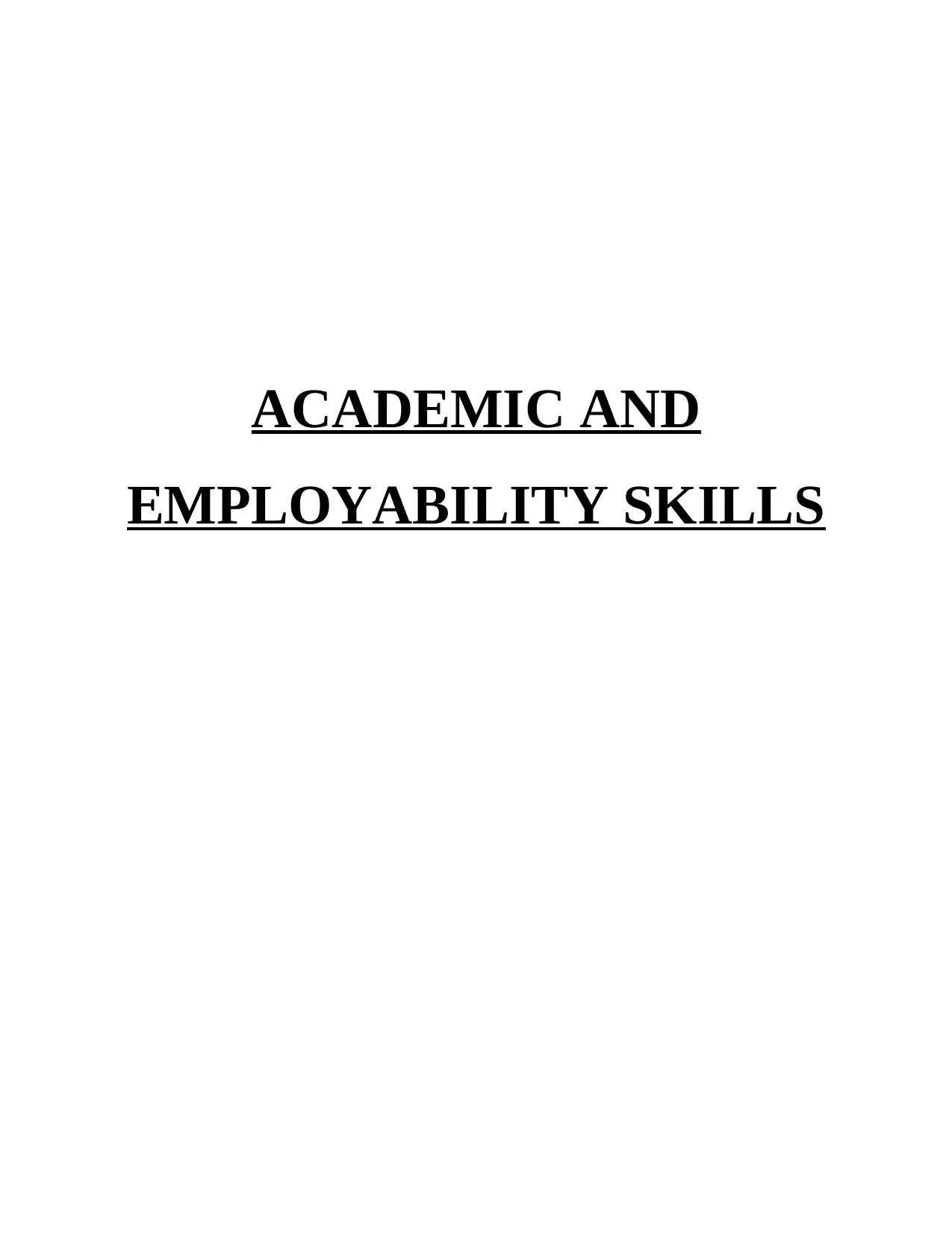
ACADEMIC AND
EMPLOYABILITY SKILLS
EMPLOYABILITY SKILLS
Paraphrase This Document
Need a fresh take? Get an instant paraphrase of this document with our AI Paraphraser
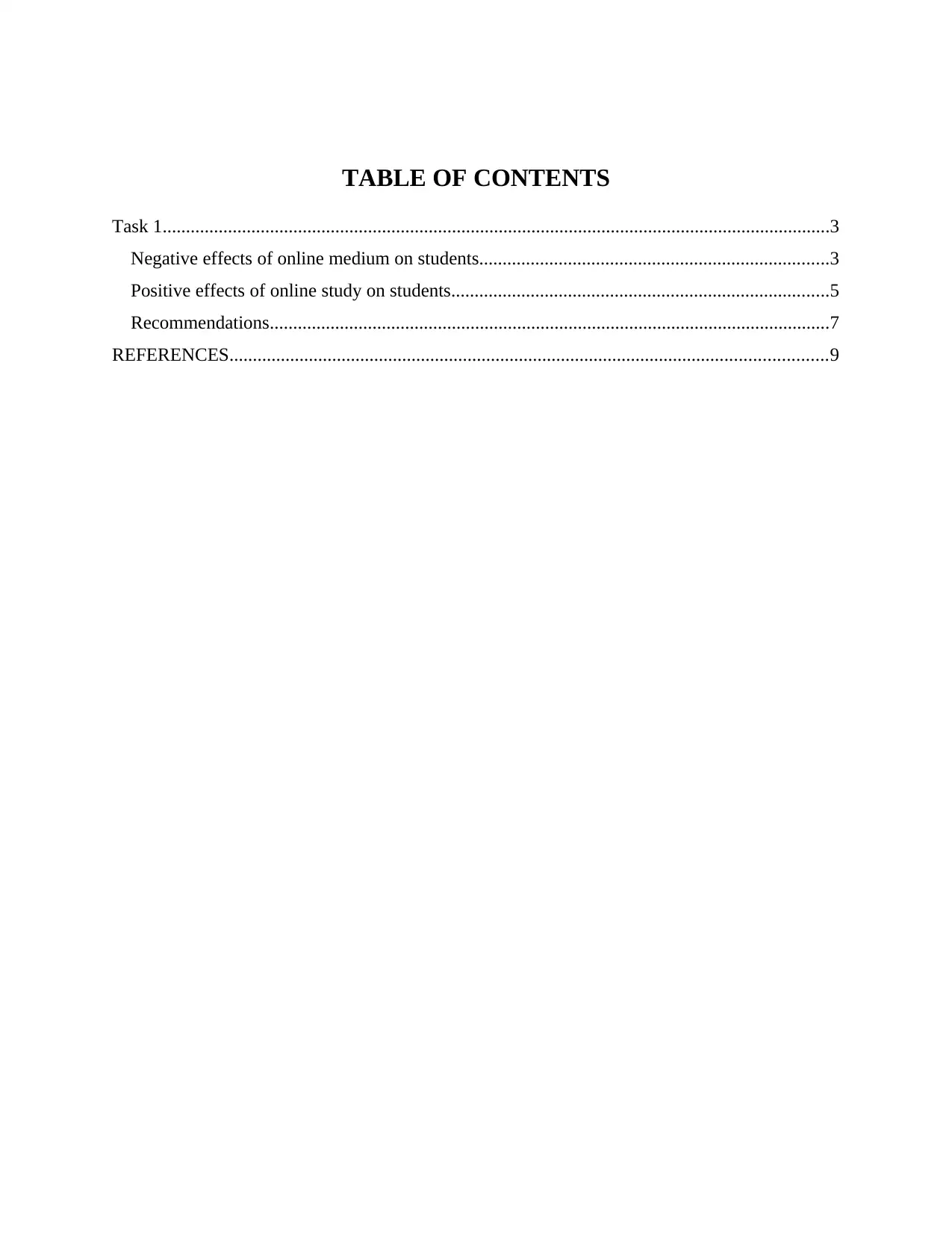
TABLE OF CONTENTS
Task 1...............................................................................................................................................3
Negative effects of online medium on students...........................................................................3
Positive effects of online study on students.................................................................................5
Recommendations........................................................................................................................7
REFERENCES................................................................................................................................9
Task 1...............................................................................................................................................3
Negative effects of online medium on students...........................................................................3
Positive effects of online study on students.................................................................................5
Recommendations........................................................................................................................7
REFERENCES................................................................................................................................9
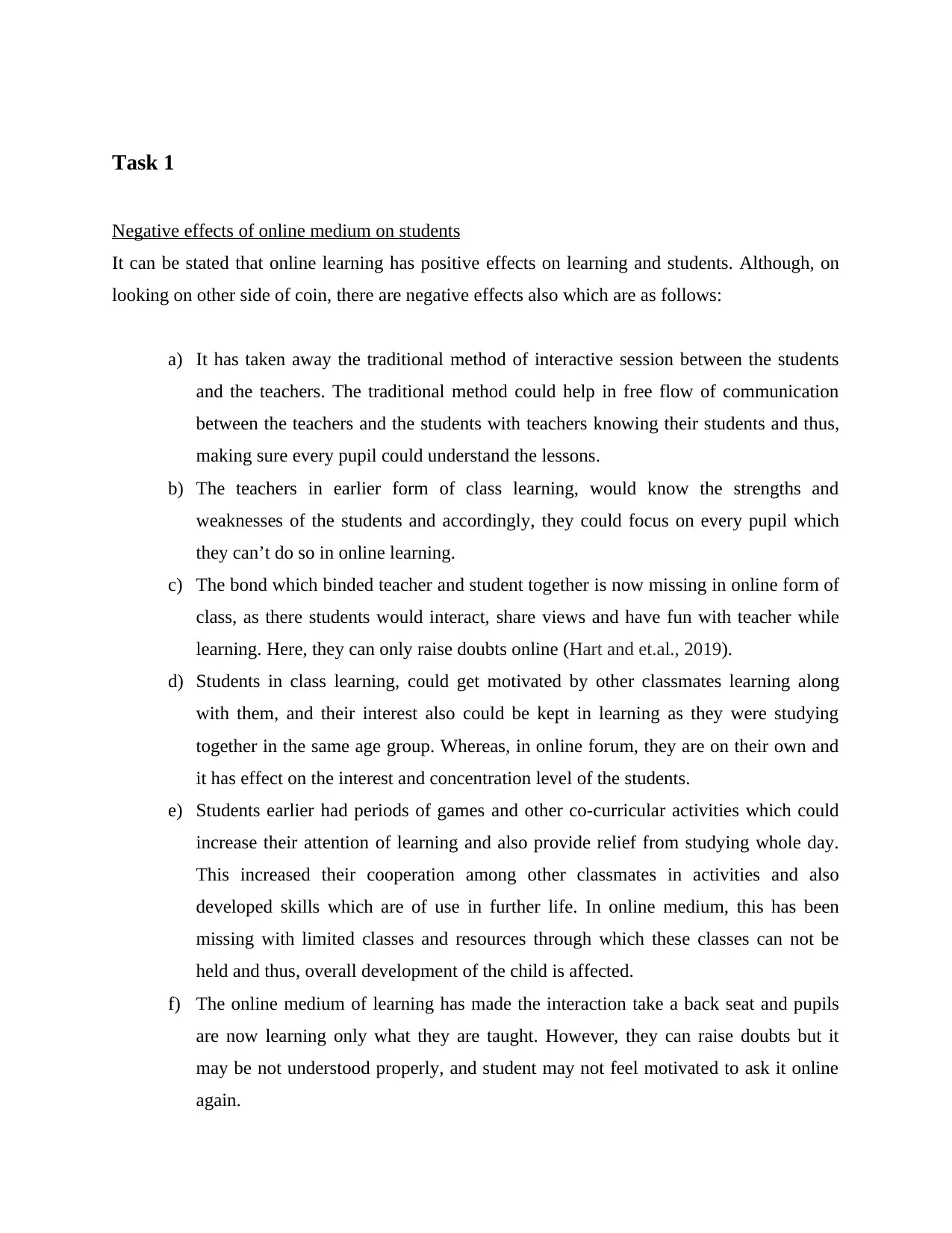
Task 1
Negative effects of online medium on students
It can be stated that online learning has positive effects on learning and students. Although, on
looking on other side of coin, there are negative effects also which are as follows:
a) It has taken away the traditional method of interactive session between the students
and the teachers. The traditional method could help in free flow of communication
between the teachers and the students with teachers knowing their students and thus,
making sure every pupil could understand the lessons.
b) The teachers in earlier form of class learning, would know the strengths and
weaknesses of the students and accordingly, they could focus on every pupil which
they can’t do so in online learning.
c) The bond which binded teacher and student together is now missing in online form of
class, as there students would interact, share views and have fun with teacher while
learning. Here, they can only raise doubts online (Hart and et.al., 2019).
d) Students in class learning, could get motivated by other classmates learning along
with them, and their interest also could be kept in learning as they were studying
together in the same age group. Whereas, in online forum, they are on their own and
it has effect on the interest and concentration level of the students.
e) Students earlier had periods of games and other co-curricular activities which could
increase their attention of learning and also provide relief from studying whole day.
This increased their cooperation among other classmates in activities and also
developed skills which are of use in further life. In online medium, this has been
missing with limited classes and resources through which these classes can not be
held and thus, overall development of the child is affected.
f) The online medium of learning has made the interaction take a back seat and pupils
are now learning only what they are taught. However, they can raise doubts but it
may be not understood properly, and student may not feel motivated to ask it online
again.
Negative effects of online medium on students
It can be stated that online learning has positive effects on learning and students. Although, on
looking on other side of coin, there are negative effects also which are as follows:
a) It has taken away the traditional method of interactive session between the students
and the teachers. The traditional method could help in free flow of communication
between the teachers and the students with teachers knowing their students and thus,
making sure every pupil could understand the lessons.
b) The teachers in earlier form of class learning, would know the strengths and
weaknesses of the students and accordingly, they could focus on every pupil which
they can’t do so in online learning.
c) The bond which binded teacher and student together is now missing in online form of
class, as there students would interact, share views and have fun with teacher while
learning. Here, they can only raise doubts online (Hart and et.al., 2019).
d) Students in class learning, could get motivated by other classmates learning along
with them, and their interest also could be kept in learning as they were studying
together in the same age group. Whereas, in online forum, they are on their own and
it has effect on the interest and concentration level of the students.
e) Students earlier had periods of games and other co-curricular activities which could
increase their attention of learning and also provide relief from studying whole day.
This increased their cooperation among other classmates in activities and also
developed skills which are of use in further life. In online medium, this has been
missing with limited classes and resources through which these classes can not be
held and thus, overall development of the child is affected.
f) The online medium of learning has made the interaction take a back seat and pupils
are now learning only what they are taught. However, they can raise doubts but it
may be not understood properly, and student may not feel motivated to ask it online
again.
⊘ This is a preview!⊘
Do you want full access?
Subscribe today to unlock all pages.

Trusted by 1+ million students worldwide
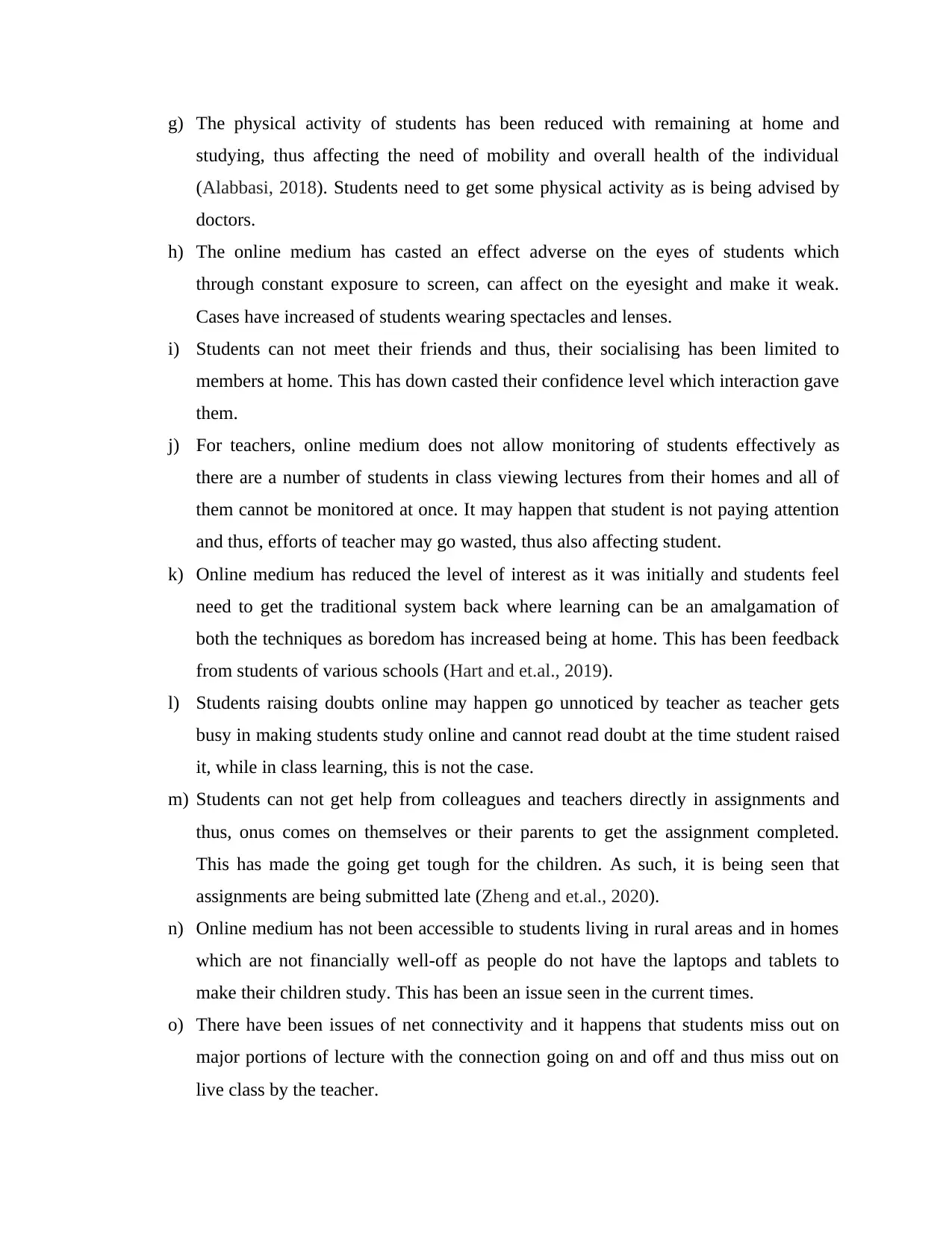
g) The physical activity of students has been reduced with remaining at home and
studying, thus affecting the need of mobility and overall health of the individual
(Alabbasi, 2018). Students need to get some physical activity as is being advised by
doctors.
h) The online medium has casted an effect adverse on the eyes of students which
through constant exposure to screen, can affect on the eyesight and make it weak.
Cases have increased of students wearing spectacles and lenses.
i) Students can not meet their friends and thus, their socialising has been limited to
members at home. This has down casted their confidence level which interaction gave
them.
j) For teachers, online medium does not allow monitoring of students effectively as
there are a number of students in class viewing lectures from their homes and all of
them cannot be monitored at once. It may happen that student is not paying attention
and thus, efforts of teacher may go wasted, thus also affecting student.
k) Online medium has reduced the level of interest as it was initially and students feel
need to get the traditional system back where learning can be an amalgamation of
both the techniques as boredom has increased being at home. This has been feedback
from students of various schools (Hart and et.al., 2019).
l) Students raising doubts online may happen go unnoticed by teacher as teacher gets
busy in making students study online and cannot read doubt at the time student raised
it, while in class learning, this is not the case.
m) Students can not get help from colleagues and teachers directly in assignments and
thus, onus comes on themselves or their parents to get the assignment completed.
This has made the going get tough for the children. As such, it is being seen that
assignments are being submitted late (Zheng and et.al., 2020).
n) Online medium has not been accessible to students living in rural areas and in homes
which are not financially well-off as people do not have the laptops and tablets to
make their children study. This has been an issue seen in the current times.
o) There have been issues of net connectivity and it happens that students miss out on
major portions of lecture with the connection going on and off and thus miss out on
live class by the teacher.
studying, thus affecting the need of mobility and overall health of the individual
(Alabbasi, 2018). Students need to get some physical activity as is being advised by
doctors.
h) The online medium has casted an effect adverse on the eyes of students which
through constant exposure to screen, can affect on the eyesight and make it weak.
Cases have increased of students wearing spectacles and lenses.
i) Students can not meet their friends and thus, their socialising has been limited to
members at home. This has down casted their confidence level which interaction gave
them.
j) For teachers, online medium does not allow monitoring of students effectively as
there are a number of students in class viewing lectures from their homes and all of
them cannot be monitored at once. It may happen that student is not paying attention
and thus, efforts of teacher may go wasted, thus also affecting student.
k) Online medium has reduced the level of interest as it was initially and students feel
need to get the traditional system back where learning can be an amalgamation of
both the techniques as boredom has increased being at home. This has been feedback
from students of various schools (Hart and et.al., 2019).
l) Students raising doubts online may happen go unnoticed by teacher as teacher gets
busy in making students study online and cannot read doubt at the time student raised
it, while in class learning, this is not the case.
m) Students can not get help from colleagues and teachers directly in assignments and
thus, onus comes on themselves or their parents to get the assignment completed.
This has made the going get tough for the children. As such, it is being seen that
assignments are being submitted late (Zheng and et.al., 2020).
n) Online medium has not been accessible to students living in rural areas and in homes
which are not financially well-off as people do not have the laptops and tablets to
make their children study. This has been an issue seen in the current times.
o) There have been issues of net connectivity and it happens that students miss out on
major portions of lecture with the connection going on and off and thus miss out on
live class by the teacher.
Paraphrase This Document
Need a fresh take? Get an instant paraphrase of this document with our AI Paraphraser
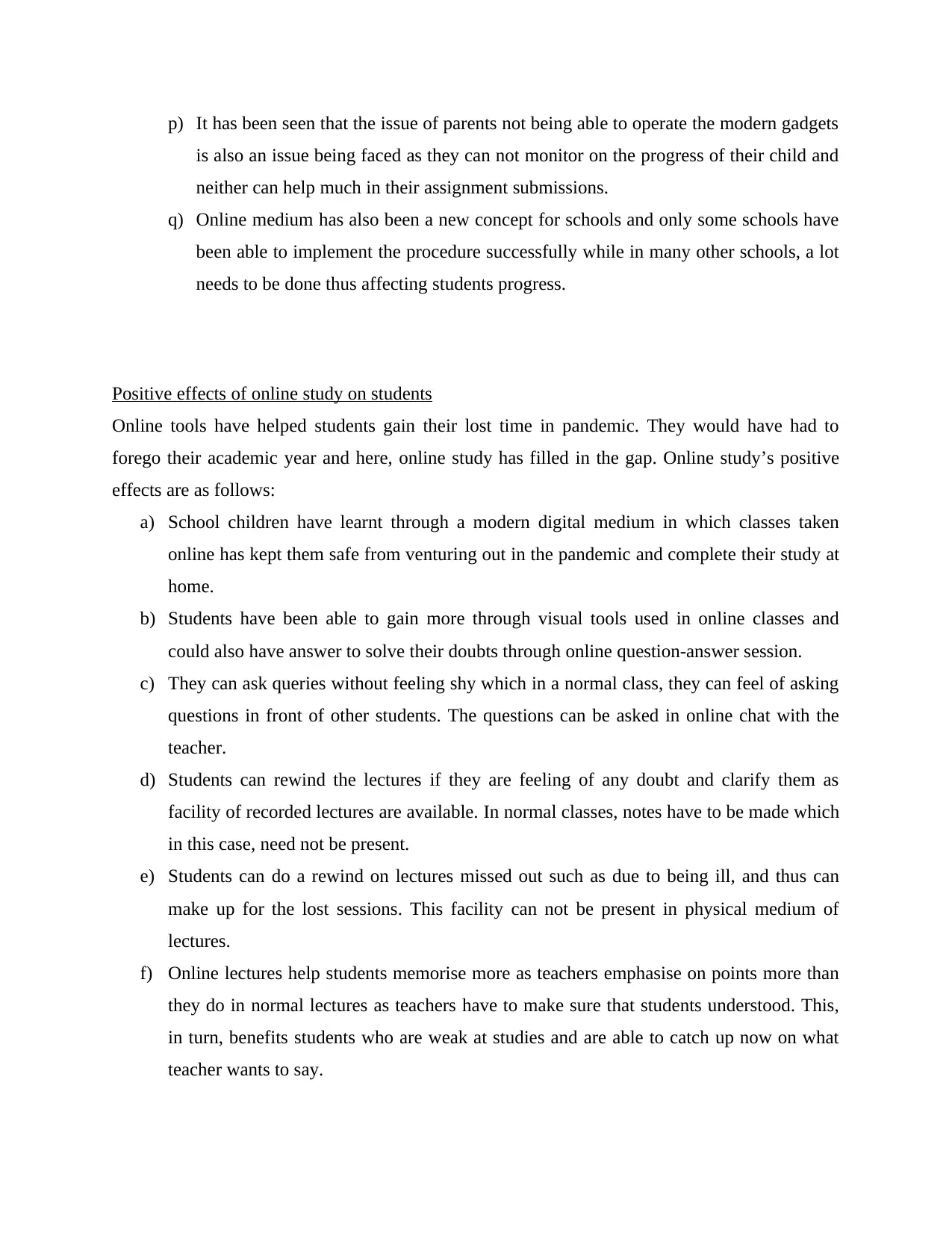
p) It has been seen that the issue of parents not being able to operate the modern gadgets
is also an issue being faced as they can not monitor on the progress of their child and
neither can help much in their assignment submissions.
q) Online medium has also been a new concept for schools and only some schools have
been able to implement the procedure successfully while in many other schools, a lot
needs to be done thus affecting students progress.
Positive effects of online study on students
Online tools have helped students gain their lost time in pandemic. They would have had to
forego their academic year and here, online study has filled in the gap. Online study’s positive
effects are as follows:
a) School children have learnt through a modern digital medium in which classes taken
online has kept them safe from venturing out in the pandemic and complete their study at
home.
b) Students have been able to gain more through visual tools used in online classes and
could also have answer to solve their doubts through online question-answer session.
c) They can ask queries without feeling shy which in a normal class, they can feel of asking
questions in front of other students. The questions can be asked in online chat with the
teacher.
d) Students can rewind the lectures if they are feeling of any doubt and clarify them as
facility of recorded lectures are available. In normal classes, notes have to be made which
in this case, need not be present.
e) Students can do a rewind on lectures missed out such as due to being ill, and thus can
make up for the lost sessions. This facility can not be present in physical medium of
lectures.
f) Online lectures help students memorise more as teachers emphasise on points more than
they do in normal lectures as teachers have to make sure that students understood. This,
in turn, benefits students who are weak at studies and are able to catch up now on what
teacher wants to say.
is also an issue being faced as they can not monitor on the progress of their child and
neither can help much in their assignment submissions.
q) Online medium has also been a new concept for schools and only some schools have
been able to implement the procedure successfully while in many other schools, a lot
needs to be done thus affecting students progress.
Positive effects of online study on students
Online tools have helped students gain their lost time in pandemic. They would have had to
forego their academic year and here, online study has filled in the gap. Online study’s positive
effects are as follows:
a) School children have learnt through a modern digital medium in which classes taken
online has kept them safe from venturing out in the pandemic and complete their study at
home.
b) Students have been able to gain more through visual tools used in online classes and
could also have answer to solve their doubts through online question-answer session.
c) They can ask queries without feeling shy which in a normal class, they can feel of asking
questions in front of other students. The questions can be asked in online chat with the
teacher.
d) Students can rewind the lectures if they are feeling of any doubt and clarify them as
facility of recorded lectures are available. In normal classes, notes have to be made which
in this case, need not be present.
e) Students can do a rewind on lectures missed out such as due to being ill, and thus can
make up for the lost sessions. This facility can not be present in physical medium of
lectures.
f) Online lectures help students memorise more as teachers emphasise on points more than
they do in normal lectures as teachers have to make sure that students understood. This,
in turn, benefits students who are weak at studies and are able to catch up now on what
teacher wants to say.
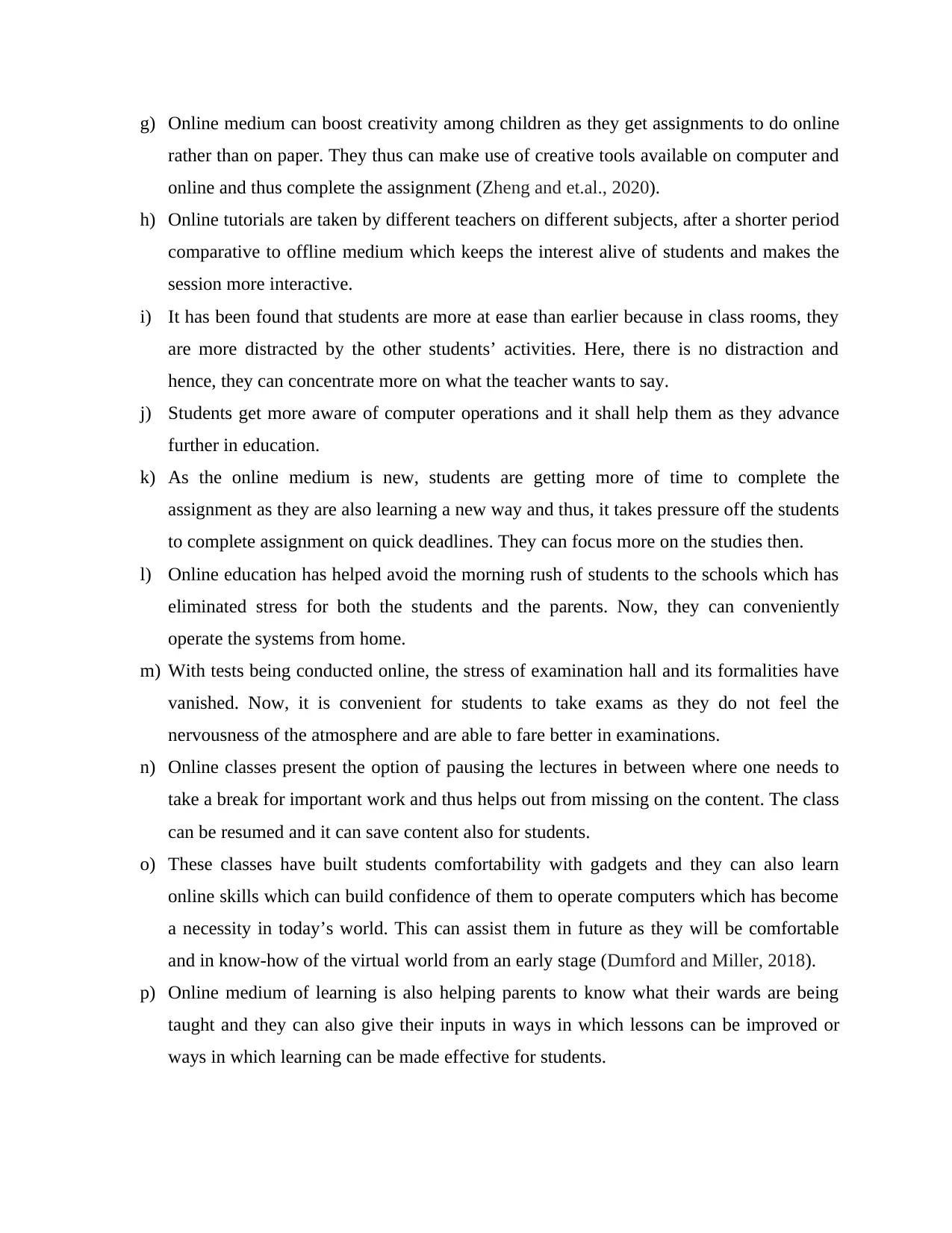
g) Online medium can boost creativity among children as they get assignments to do online
rather than on paper. They thus can make use of creative tools available on computer and
online and thus complete the assignment (Zheng and et.al., 2020).
h) Online tutorials are taken by different teachers on different subjects, after a shorter period
comparative to offline medium which keeps the interest alive of students and makes the
session more interactive.
i) It has been found that students are more at ease than earlier because in class rooms, they
are more distracted by the other students’ activities. Here, there is no distraction and
hence, they can concentrate more on what the teacher wants to say.
j) Students get more aware of computer operations and it shall help them as they advance
further in education.
k) As the online medium is new, students are getting more of time to complete the
assignment as they are also learning a new way and thus, it takes pressure off the students
to complete assignment on quick deadlines. They can focus more on the studies then.
l) Online education has helped avoid the morning rush of students to the schools which has
eliminated stress for both the students and the parents. Now, they can conveniently
operate the systems from home.
m) With tests being conducted online, the stress of examination hall and its formalities have
vanished. Now, it is convenient for students to take exams as they do not feel the
nervousness of the atmosphere and are able to fare better in examinations.
n) Online classes present the option of pausing the lectures in between where one needs to
take a break for important work and thus helps out from missing on the content. The class
can be resumed and it can save content also for students.
o) These classes have built students comfortability with gadgets and they can also learn
online skills which can build confidence of them to operate computers which has become
a necessity in today’s world. This can assist them in future as they will be comfortable
and in know-how of the virtual world from an early stage (Dumford and Miller, 2018).
p) Online medium of learning is also helping parents to know what their wards are being
taught and they can also give their inputs in ways in which lessons can be improved or
ways in which learning can be made effective for students.
rather than on paper. They thus can make use of creative tools available on computer and
online and thus complete the assignment (Zheng and et.al., 2020).
h) Online tutorials are taken by different teachers on different subjects, after a shorter period
comparative to offline medium which keeps the interest alive of students and makes the
session more interactive.
i) It has been found that students are more at ease than earlier because in class rooms, they
are more distracted by the other students’ activities. Here, there is no distraction and
hence, they can concentrate more on what the teacher wants to say.
j) Students get more aware of computer operations and it shall help them as they advance
further in education.
k) As the online medium is new, students are getting more of time to complete the
assignment as they are also learning a new way and thus, it takes pressure off the students
to complete assignment on quick deadlines. They can focus more on the studies then.
l) Online education has helped avoid the morning rush of students to the schools which has
eliminated stress for both the students and the parents. Now, they can conveniently
operate the systems from home.
m) With tests being conducted online, the stress of examination hall and its formalities have
vanished. Now, it is convenient for students to take exams as they do not feel the
nervousness of the atmosphere and are able to fare better in examinations.
n) Online classes present the option of pausing the lectures in between where one needs to
take a break for important work and thus helps out from missing on the content. The class
can be resumed and it can save content also for students.
o) These classes have built students comfortability with gadgets and they can also learn
online skills which can build confidence of them to operate computers which has become
a necessity in today’s world. This can assist them in future as they will be comfortable
and in know-how of the virtual world from an early stage (Dumford and Miller, 2018).
p) Online medium of learning is also helping parents to know what their wards are being
taught and they can also give their inputs in ways in which lessons can be improved or
ways in which learning can be made effective for students.
⊘ This is a preview!⊘
Do you want full access?
Subscribe today to unlock all pages.

Trusted by 1+ million students worldwide
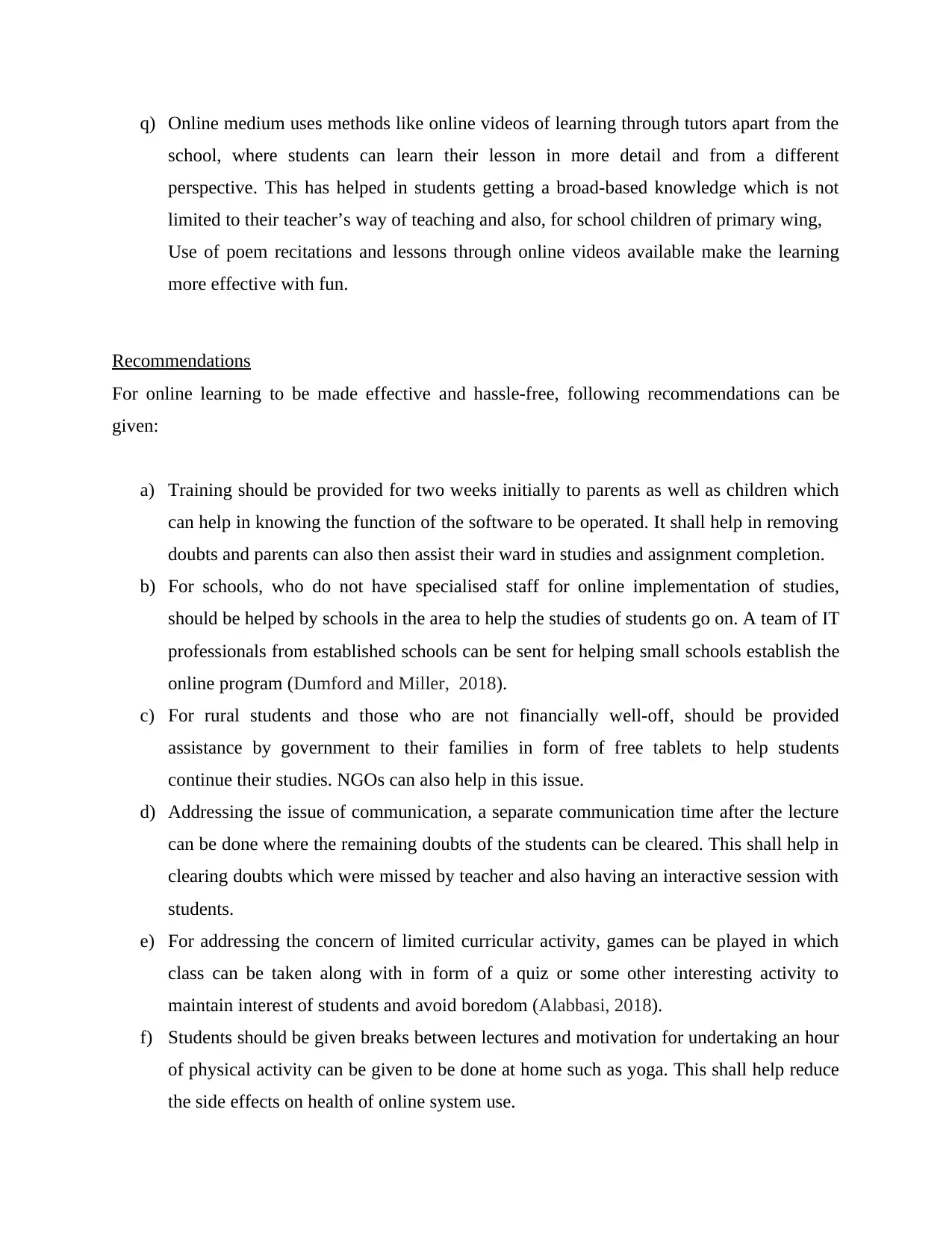
q) Online medium uses methods like online videos of learning through tutors apart from the
school, where students can learn their lesson in more detail and from a different
perspective. This has helped in students getting a broad-based knowledge which is not
limited to their teacher’s way of teaching and also, for school children of primary wing,
Use of poem recitations and lessons through online videos available make the learning
more effective with fun.
Recommendations
For online learning to be made effective and hassle-free, following recommendations can be
given:
a) Training should be provided for two weeks initially to parents as well as children which
can help in knowing the function of the software to be operated. It shall help in removing
doubts and parents can also then assist their ward in studies and assignment completion.
b) For schools, who do not have specialised staff for online implementation of studies,
should be helped by schools in the area to help the studies of students go on. A team of IT
professionals from established schools can be sent for helping small schools establish the
online program (Dumford and Miller, 2018).
c) For rural students and those who are not financially well-off, should be provided
assistance by government to their families in form of free tablets to help students
continue their studies. NGOs can also help in this issue.
d) Addressing the issue of communication, a separate communication time after the lecture
can be done where the remaining doubts of the students can be cleared. This shall help in
clearing doubts which were missed by teacher and also having an interactive session with
students.
e) For addressing the concern of limited curricular activity, games can be played in which
class can be taken along with in form of a quiz or some other interesting activity to
maintain interest of students and avoid boredom (Alabbasi, 2018).
f) Students should be given breaks between lectures and motivation for undertaking an hour
of physical activity can be given to be done at home such as yoga. This shall help reduce
the side effects on health of online system use.
school, where students can learn their lesson in more detail and from a different
perspective. This has helped in students getting a broad-based knowledge which is not
limited to their teacher’s way of teaching and also, for school children of primary wing,
Use of poem recitations and lessons through online videos available make the learning
more effective with fun.
Recommendations
For online learning to be made effective and hassle-free, following recommendations can be
given:
a) Training should be provided for two weeks initially to parents as well as children which
can help in knowing the function of the software to be operated. It shall help in removing
doubts and parents can also then assist their ward in studies and assignment completion.
b) For schools, who do not have specialised staff for online implementation of studies,
should be helped by schools in the area to help the studies of students go on. A team of IT
professionals from established schools can be sent for helping small schools establish the
online program (Dumford and Miller, 2018).
c) For rural students and those who are not financially well-off, should be provided
assistance by government to their families in form of free tablets to help students
continue their studies. NGOs can also help in this issue.
d) Addressing the issue of communication, a separate communication time after the lecture
can be done where the remaining doubts of the students can be cleared. This shall help in
clearing doubts which were missed by teacher and also having an interactive session with
students.
e) For addressing the concern of limited curricular activity, games can be played in which
class can be taken along with in form of a quiz or some other interesting activity to
maintain interest of students and avoid boredom (Alabbasi, 2018).
f) Students should be given breaks between lectures and motivation for undertaking an hour
of physical activity can be given to be done at home such as yoga. This shall help reduce
the side effects on health of online system use.
Paraphrase This Document
Need a fresh take? Get an instant paraphrase of this document with our AI Paraphraser
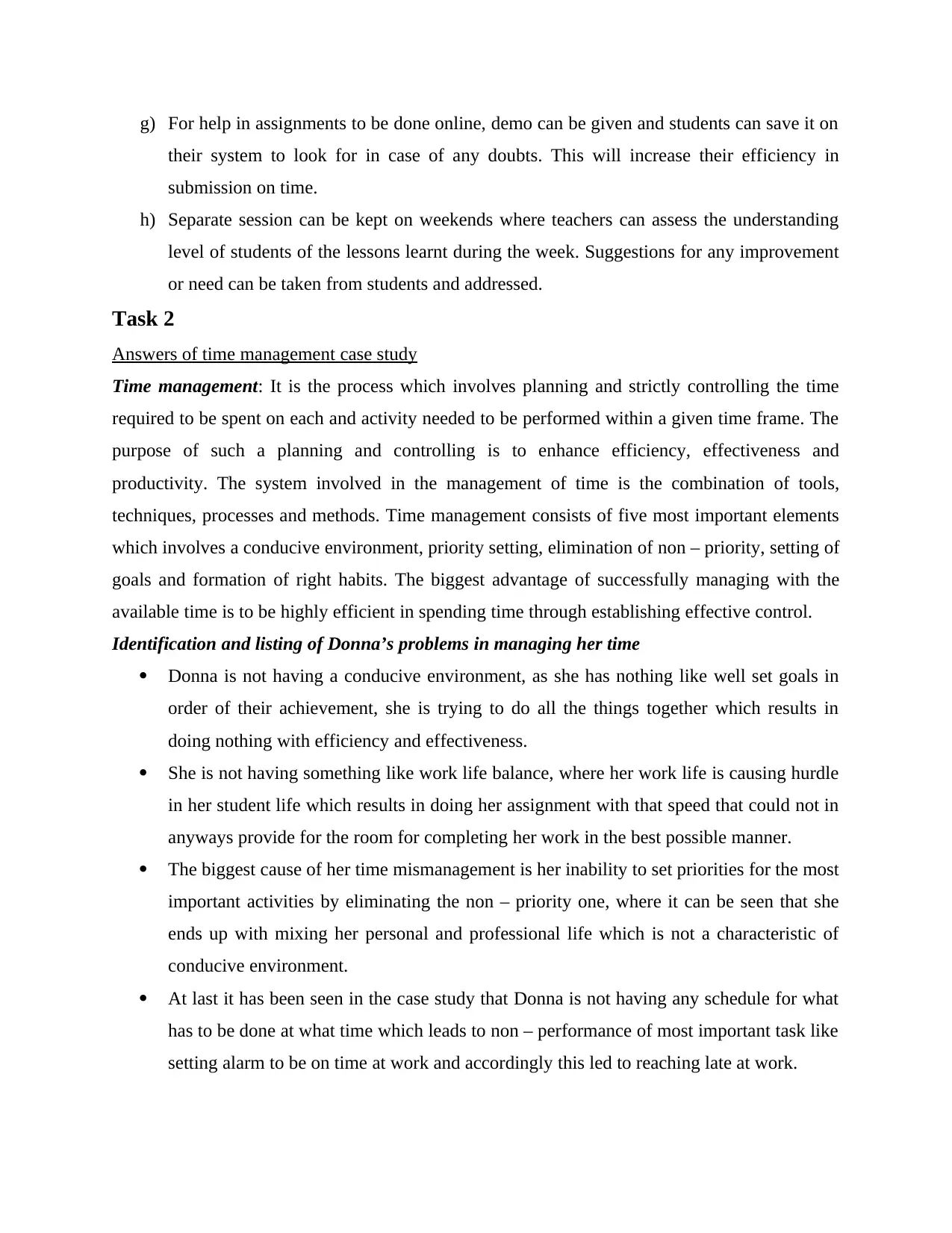
g) For help in assignments to be done online, demo can be given and students can save it on
their system to look for in case of any doubts. This will increase their efficiency in
submission on time.
h) Separate session can be kept on weekends where teachers can assess the understanding
level of students of the lessons learnt during the week. Suggestions for any improvement
or need can be taken from students and addressed.
Task 2
Answers of time management case study
Time management: It is the process which involves planning and strictly controlling the time
required to be spent on each and activity needed to be performed within a given time frame. The
purpose of such a planning and controlling is to enhance efficiency, effectiveness and
productivity. The system involved in the management of time is the combination of tools,
techniques, processes and methods. Time management consists of five most important elements
which involves a conducive environment, priority setting, elimination of non – priority, setting of
goals and formation of right habits. The biggest advantage of successfully managing with the
available time is to be highly efficient in spending time through establishing effective control.
Identification and listing of Donna’s problems in managing her time
Donna is not having a conducive environment, as she has nothing like well set goals in
order of their achievement, she is trying to do all the things together which results in
doing nothing with efficiency and effectiveness.
She is not having something like work life balance, where her work life is causing hurdle
in her student life which results in doing her assignment with that speed that could not in
anyways provide for the room for completing her work in the best possible manner.
The biggest cause of her time mismanagement is her inability to set priorities for the most
important activities by eliminating the non – priority one, where it can be seen that she
ends up with mixing her personal and professional life which is not a characteristic of
conducive environment.
At last it has been seen in the case study that Donna is not having any schedule for what
has to be done at what time which leads to non – performance of most important task like
setting alarm to be on time at work and accordingly this led to reaching late at work.
their system to look for in case of any doubts. This will increase their efficiency in
submission on time.
h) Separate session can be kept on weekends where teachers can assess the understanding
level of students of the lessons learnt during the week. Suggestions for any improvement
or need can be taken from students and addressed.
Task 2
Answers of time management case study
Time management: It is the process which involves planning and strictly controlling the time
required to be spent on each and activity needed to be performed within a given time frame. The
purpose of such a planning and controlling is to enhance efficiency, effectiveness and
productivity. The system involved in the management of time is the combination of tools,
techniques, processes and methods. Time management consists of five most important elements
which involves a conducive environment, priority setting, elimination of non – priority, setting of
goals and formation of right habits. The biggest advantage of successfully managing with the
available time is to be highly efficient in spending time through establishing effective control.
Identification and listing of Donna’s problems in managing her time
Donna is not having a conducive environment, as she has nothing like well set goals in
order of their achievement, she is trying to do all the things together which results in
doing nothing with efficiency and effectiveness.
She is not having something like work life balance, where her work life is causing hurdle
in her student life which results in doing her assignment with that speed that could not in
anyways provide for the room for completing her work in the best possible manner.
The biggest cause of her time mismanagement is her inability to set priorities for the most
important activities by eliminating the non – priority one, where it can be seen that she
ends up with mixing her personal and professional life which is not a characteristic of
conducive environment.
At last it has been seen in the case study that Donna is not having any schedule for what
has to be done at what time which leads to non – performance of most important task like
setting alarm to be on time at work and accordingly this led to reaching late at work.
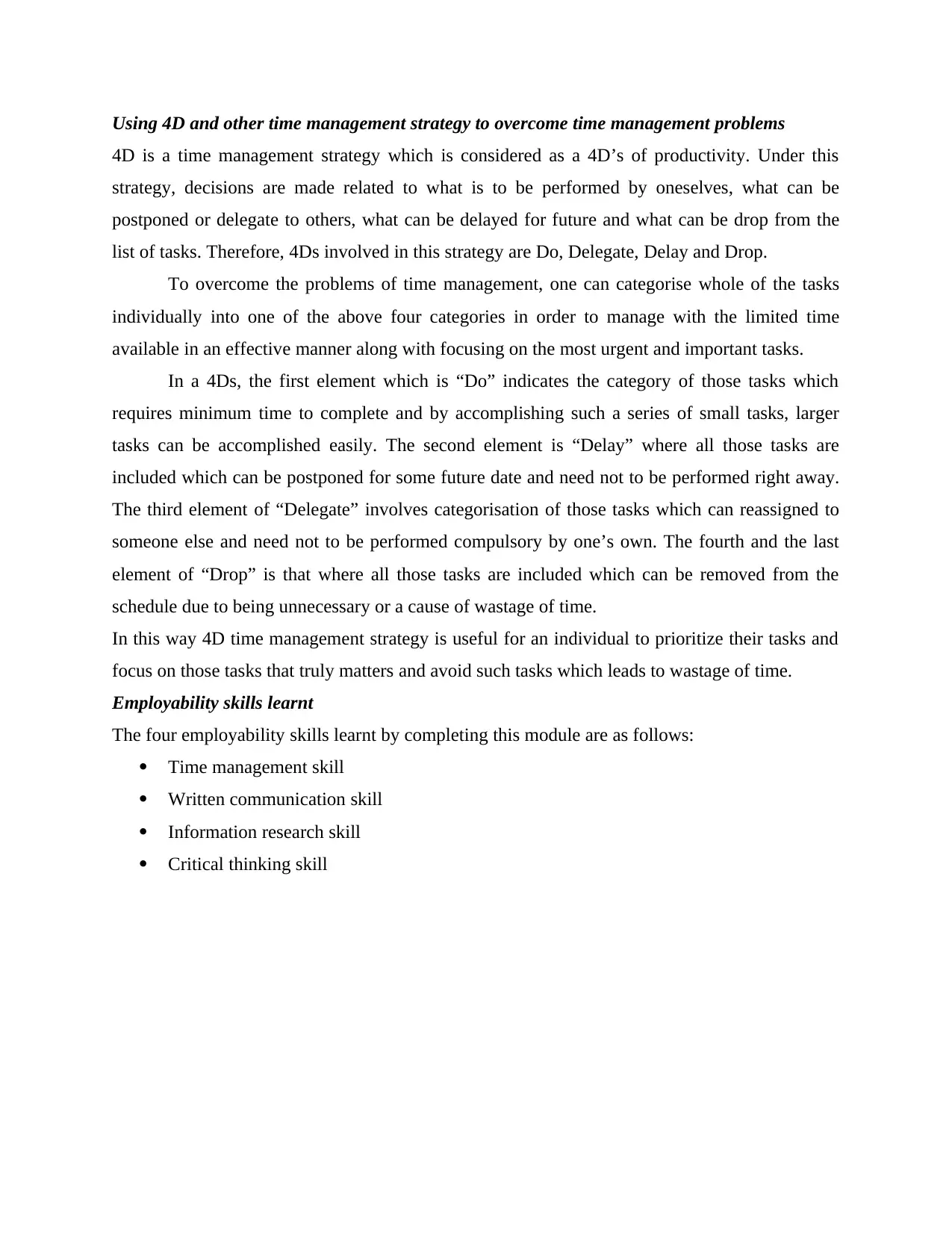
Using 4D and other time management strategy to overcome time management problems
4D is a time management strategy which is considered as a 4D’s of productivity. Under this
strategy, decisions are made related to what is to be performed by oneselves, what can be
postponed or delegate to others, what can be delayed for future and what can be drop from the
list of tasks. Therefore, 4Ds involved in this strategy are Do, Delegate, Delay and Drop.
To overcome the problems of time management, one can categorise whole of the tasks
individually into one of the above four categories in order to manage with the limited time
available in an effective manner along with focusing on the most urgent and important tasks.
In a 4Ds, the first element which is “Do” indicates the category of those tasks which
requires minimum time to complete and by accomplishing such a series of small tasks, larger
tasks can be accomplished easily. The second element is “Delay” where all those tasks are
included which can be postponed for some future date and need not to be performed right away.
The third element of “Delegate” involves categorisation of those tasks which can reassigned to
someone else and need not to be performed compulsory by one’s own. The fourth and the last
element of “Drop” is that where all those tasks are included which can be removed from the
schedule due to being unnecessary or a cause of wastage of time.
In this way 4D time management strategy is useful for an individual to prioritize their tasks and
focus on those tasks that truly matters and avoid such tasks which leads to wastage of time.
Employability skills learnt
The four employability skills learnt by completing this module are as follows:
Time management skill
Written communication skill
Information research skill
Critical thinking skill
4D is a time management strategy which is considered as a 4D’s of productivity. Under this
strategy, decisions are made related to what is to be performed by oneselves, what can be
postponed or delegate to others, what can be delayed for future and what can be drop from the
list of tasks. Therefore, 4Ds involved in this strategy are Do, Delegate, Delay and Drop.
To overcome the problems of time management, one can categorise whole of the tasks
individually into one of the above four categories in order to manage with the limited time
available in an effective manner along with focusing on the most urgent and important tasks.
In a 4Ds, the first element which is “Do” indicates the category of those tasks which
requires minimum time to complete and by accomplishing such a series of small tasks, larger
tasks can be accomplished easily. The second element is “Delay” where all those tasks are
included which can be postponed for some future date and need not to be performed right away.
The third element of “Delegate” involves categorisation of those tasks which can reassigned to
someone else and need not to be performed compulsory by one’s own. The fourth and the last
element of “Drop” is that where all those tasks are included which can be removed from the
schedule due to being unnecessary or a cause of wastage of time.
In this way 4D time management strategy is useful for an individual to prioritize their tasks and
focus on those tasks that truly matters and avoid such tasks which leads to wastage of time.
Employability skills learnt
The four employability skills learnt by completing this module are as follows:
Time management skill
Written communication skill
Information research skill
Critical thinking skill
⊘ This is a preview!⊘
Do you want full access?
Subscribe today to unlock all pages.

Trusted by 1+ million students worldwide
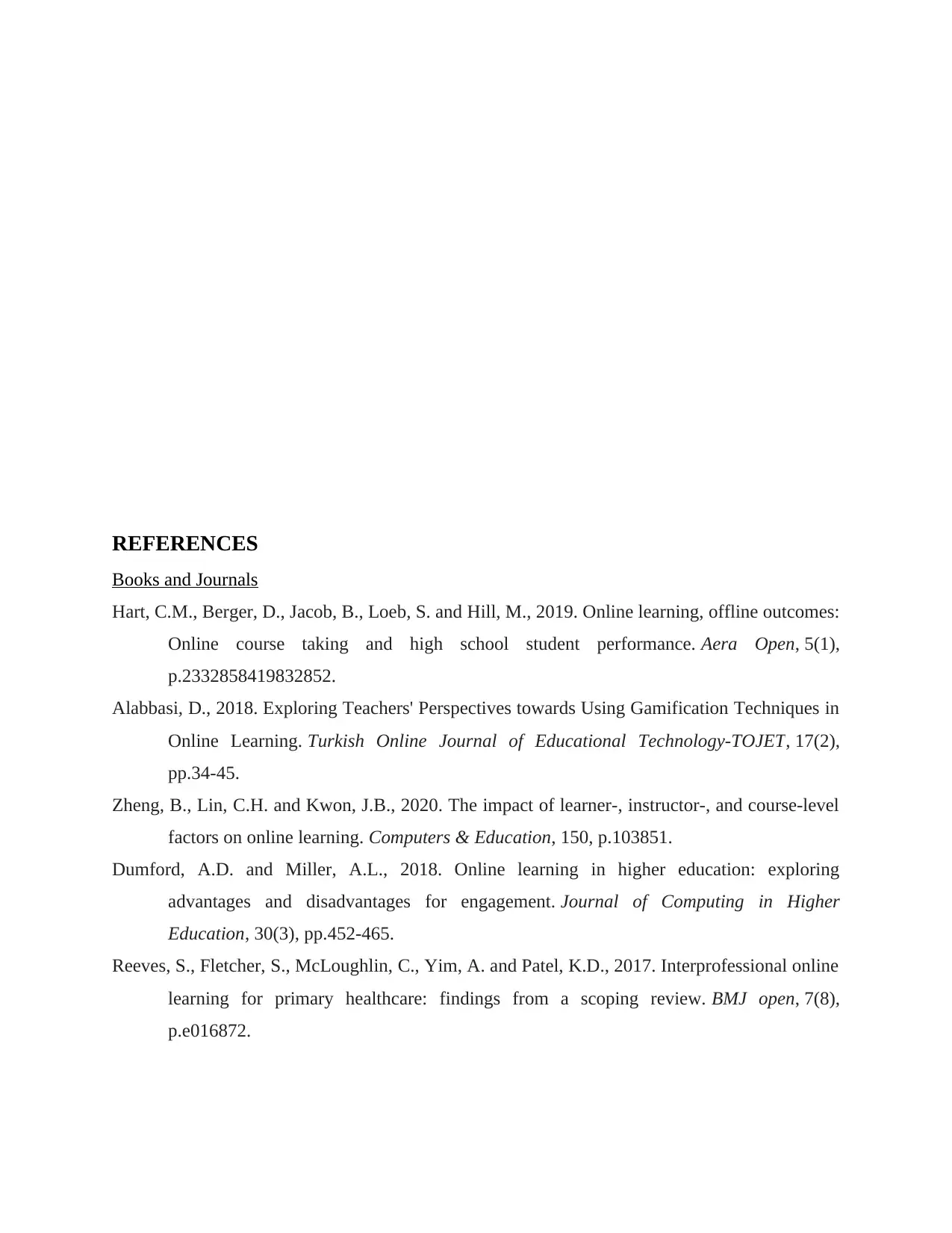
REFERENCES
Books and Journals
Hart, C.M., Berger, D., Jacob, B., Loeb, S. and Hill, M., 2019. Online learning, offline outcomes:
Online course taking and high school student performance. Aera Open, 5(1),
p.2332858419832852.
Alabbasi, D., 2018. Exploring Teachers' Perspectives towards Using Gamification Techniques in
Online Learning. Turkish Online Journal of Educational Technology-TOJET, 17(2),
pp.34-45.
Zheng, B., Lin, C.H. and Kwon, J.B., 2020. The impact of learner-, instructor-, and course-level
factors on online learning. Computers & Education, 150, p.103851.
Dumford, A.D. and Miller, A.L., 2018. Online learning in higher education: exploring
advantages and disadvantages for engagement. Journal of Computing in Higher
Education, 30(3), pp.452-465.
Reeves, S., Fletcher, S., McLoughlin, C., Yim, A. and Patel, K.D., 2017. Interprofessional online
learning for primary healthcare: findings from a scoping review. BMJ open, 7(8),
p.e016872.
Books and Journals
Hart, C.M., Berger, D., Jacob, B., Loeb, S. and Hill, M., 2019. Online learning, offline outcomes:
Online course taking and high school student performance. Aera Open, 5(1),
p.2332858419832852.
Alabbasi, D., 2018. Exploring Teachers' Perspectives towards Using Gamification Techniques in
Online Learning. Turkish Online Journal of Educational Technology-TOJET, 17(2),
pp.34-45.
Zheng, B., Lin, C.H. and Kwon, J.B., 2020. The impact of learner-, instructor-, and course-level
factors on online learning. Computers & Education, 150, p.103851.
Dumford, A.D. and Miller, A.L., 2018. Online learning in higher education: exploring
advantages and disadvantages for engagement. Journal of Computing in Higher
Education, 30(3), pp.452-465.
Reeves, S., Fletcher, S., McLoughlin, C., Yim, A. and Patel, K.D., 2017. Interprofessional online
learning for primary healthcare: findings from a scoping review. BMJ open, 7(8),
p.e016872.
Paraphrase This Document
Need a fresh take? Get an instant paraphrase of this document with our AI Paraphraser
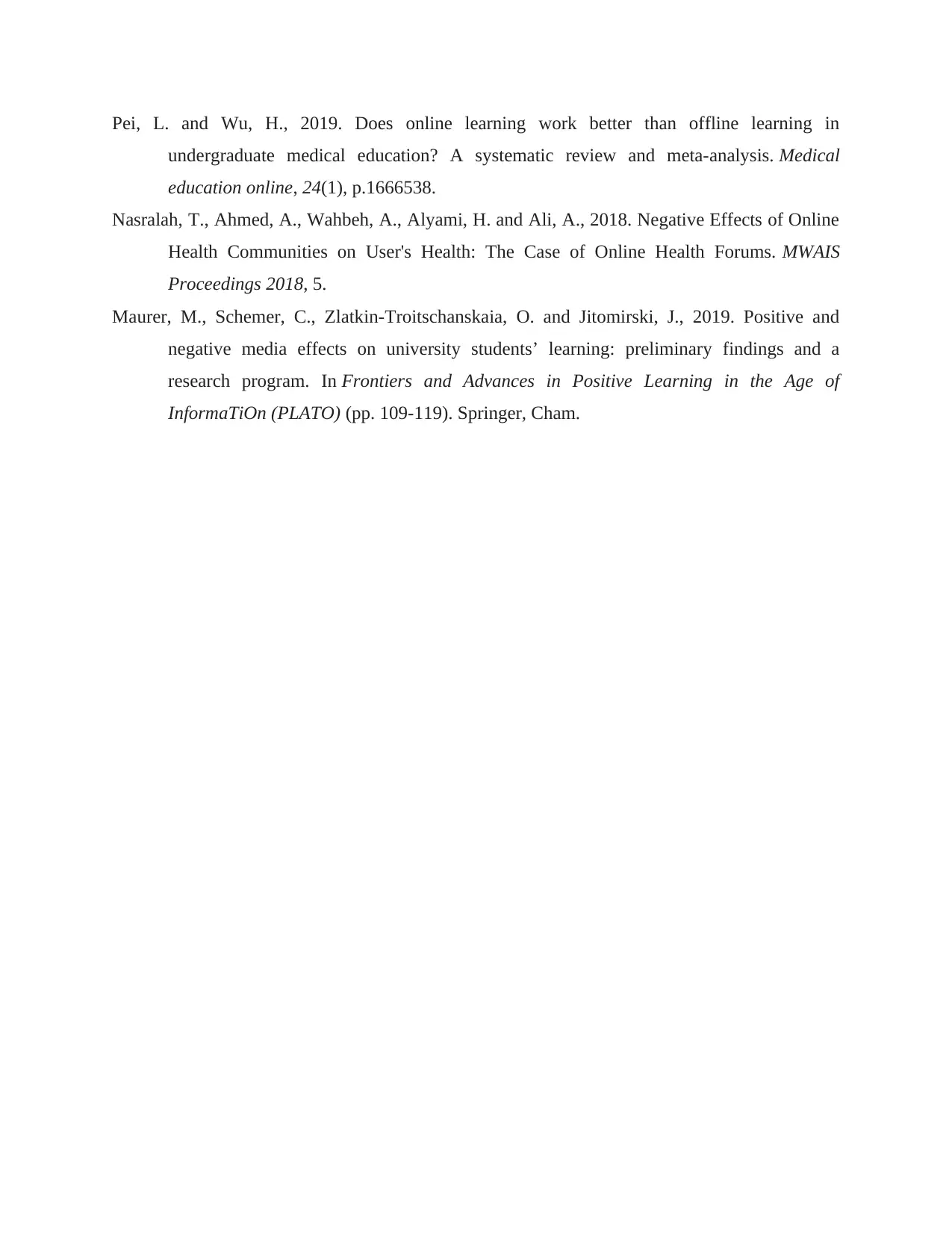
Pei, L. and Wu, H., 2019. Does online learning work better than offline learning in
undergraduate medical education? A systematic review and meta-analysis. Medical
education online, 24(1), p.1666538.
Nasralah, T., Ahmed, A., Wahbeh, A., Alyami, H. and Ali, A., 2018. Negative Effects of Online
Health Communities on User's Health: The Case of Online Health Forums. MWAIS
Proceedings 2018, 5.
Maurer, M., Schemer, C., Zlatkin-Troitschanskaia, O. and Jitomirski, J., 2019. Positive and
negative media effects on university students’ learning: preliminary findings and a
research program. In Frontiers and Advances in Positive Learning in the Age of
InformaTiOn (PLATO) (pp. 109-119). Springer, Cham.
undergraduate medical education? A systematic review and meta-analysis. Medical
education online, 24(1), p.1666538.
Nasralah, T., Ahmed, A., Wahbeh, A., Alyami, H. and Ali, A., 2018. Negative Effects of Online
Health Communities on User's Health: The Case of Online Health Forums. MWAIS
Proceedings 2018, 5.
Maurer, M., Schemer, C., Zlatkin-Troitschanskaia, O. and Jitomirski, J., 2019. Positive and
negative media effects on university students’ learning: preliminary findings and a
research program. In Frontiers and Advances in Positive Learning in the Age of
InformaTiOn (PLATO) (pp. 109-119). Springer, Cham.

⊘ This is a preview!⊘
Do you want full access?
Subscribe today to unlock all pages.

Trusted by 1+ million students worldwide
1 out of 20
Related Documents
Your All-in-One AI-Powered Toolkit for Academic Success.
+13062052269
info@desklib.com
Available 24*7 on WhatsApp / Email
![[object Object]](/_next/static/media/star-bottom.7253800d.svg)
Unlock your academic potential
Copyright © 2020–2025 A2Z Services. All Rights Reserved. Developed and managed by ZUCOL.





